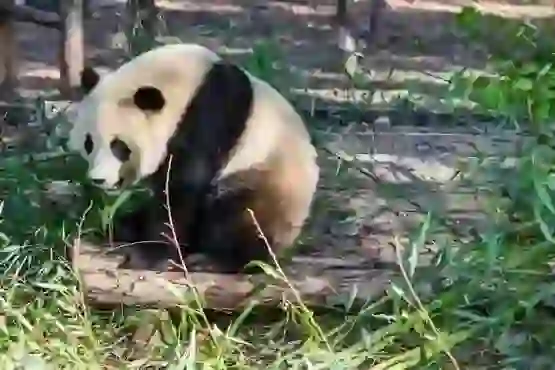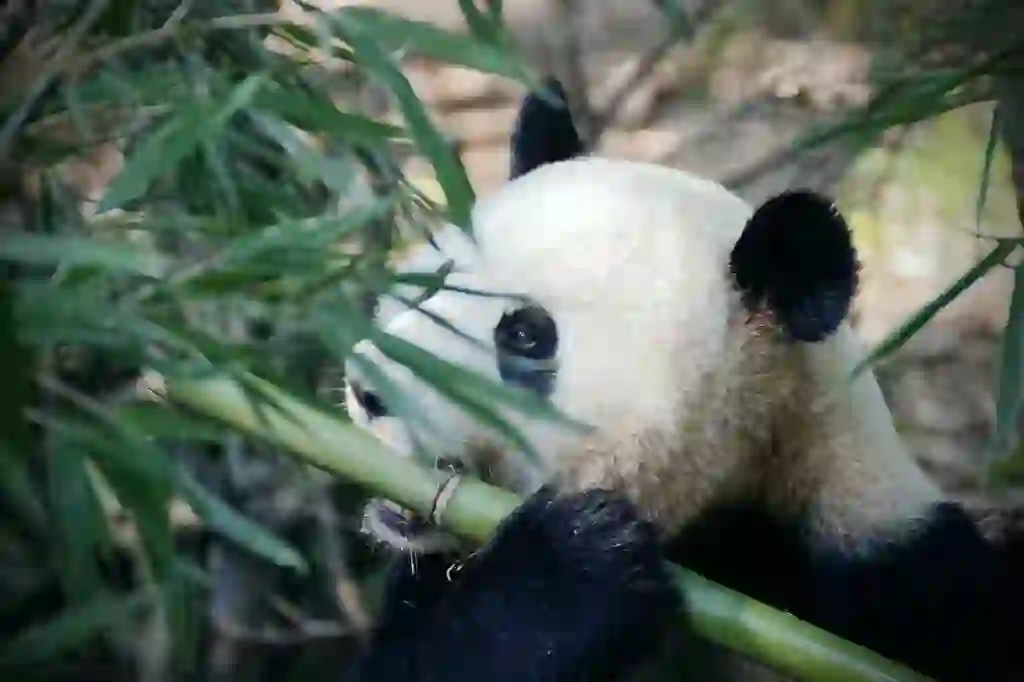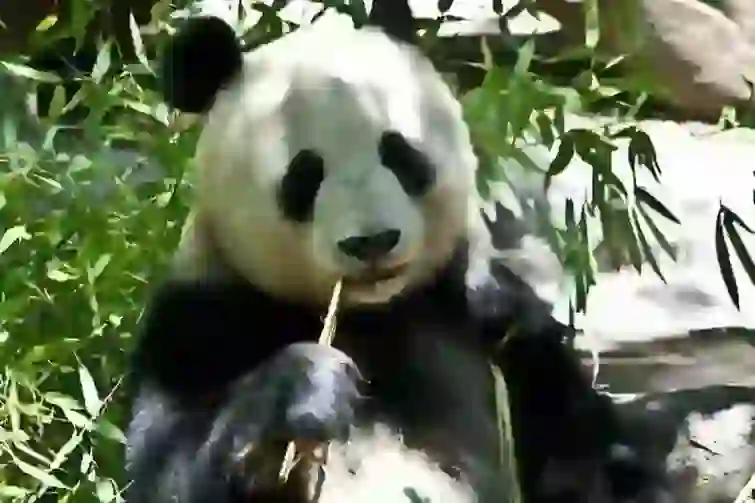
Giant Panda
Giant Panda
Giant Panda
The giant panda is a popular animal in zoos! When a baby is born, it is often featured on TV and in magazines. The round and cute appearance and the sight of them eating bamboo are very cute. However, behind the cute appearance of the giant panda, there are some surprising aspects. Why don’t you explore the charm of the giant panda, which is not just cute?
Giant Panda Basic Infomation

Mammalia-Carnivora-Ursidae-Giant_panda genus.
Length 120~150cm long tail 10~15cm.
Weight male:100kg female:90kg.
The main habitat is the Himalayas and China. In China, they live in bamboo forests on high mountains.
They have a bear-like shape and a sturdy build. The head is round, the body is thick and short, and the front and rear legs are muscular and thick.
There are protrusions shaped like fingers on the thumb and little finger sides of the panda’s hand. This part is also called the 6th or 7th finger because it plays a very useful role in grabbing bamboo branches or climbing bamboo.
The hair is composed of two colors, white and black, with black around the eyes, ears, front legs, and hind legs and white on other parts. They were once called “color separation bears” because of their appearance.
It seems that it is quite difficult to distinguish between male and female pandas.That’s why they identify it by the genitalia in their stomachs, but panda genitalia is very small, and there have been cases in China where they thought it was a female but it was actually a male.
The breeding season for pandas is said to be between February and May. In the wild, males "mark" trees and other objects to inform females of their location. And females rely on this scent to search for males.
The breeding season is the same even if they are kept in captivity.
The lifespan of a panda is said to be about 20 to 30 years. Some pandas have been confirmed to have lived for 34 years.
Giant pandas mainly eat bamboo leaves and bamboo shoots, and rarely insects and mice.
Giant pandas have a strong image of eating a lot of bamboo, but they are actually carnivorous omnivores.
Giant Panda Q&A

Why is the body of a giant panda white and black?
When it comes to giant pandas, their black and white two-tone color is famous. Other bears are either all black or all brown…
Why do giant pandas have this kind of fur?
There are several reasons, but one is that the environment in China, which is famous for being the main habitat of giant pandas, may be involved.
In the mountainous areas of China where giant pandas live, it snows in winter. Then, the white part of the body is more likely to blend in with the surrounding snow scenery, making it less vulnerable to external enemies.
Also, when it comes to color, black is said to absorb heat better than white.
It is thought that the front and back legs turned black so as not to cool down the hands and feet even a little on cold snowy days.

What is the personality of a giant panda like?
Many people may have seen giant pandas lying on grass or using their front legs skillfully to eat bamboo leisurely when they go to the zoo.
To put it simply, the personality of giant pandas is basically gentle as it looks.
Especially when they are young, their personality is full of curiosity and they look very cute when they stick to humans. However, pandas are originally bears, so there have been cases where even usually gentle giant pandas attacked people when they played pranks or caused harm.
Even though giant pandas are carnivorous, it may be that their ferocity has gradually decreased since they started eating bamboo frequently.

Where does the giant panda get its name?
We often say things like “There’s a panda! How cute!” without thinking, but why did it become known as a panda instead of something bear?
Interestingly, the origin of the word “panda” is said to come from Nepali.
First of all, there is the theory that "Nigarya Bonya (Ponya)", which means "bamboo eater", turned into a panda, and the theory that "Panja", which means "palm", became a panda.
If anything, "Nigarya Bonya (Ponya)" would be more correct, wouldn't it? However, both seem to be mere speculations due to the lack of solid evidence.

Is it true that giant pandas don't hibernate?
Other bears such as brown bears and Asian black bear generally hibernate in winter, but you may not have heard that giant pandas hibernate.
The reason why giant pandas do not hibernate is largely due to the presence of bamboo, which is their main food.
First of all, when winter comes, grass and trees wither and fruits do not ripen much, so food temporarily becomes scarce.
Animals will die if they go without food for days, so they eat a lot of food in autumn to store energy and spend the winter without eating or drinking. This is the mechanism of hibernation.
However, bamboo does not wither even in winter. It is a plant that can be eaten all year round, so there is no reason to store food.
Even if they tried to hibernate and stored a lot of bamboo, the calorie content of bamboo is low and cannot provide energy for a long time even if eaten in large quantities. Therefore, it is not suitable for hibernation and there is no need to do so environmentally.

Is it true that the number of giant pandas is decreasing?
To put it simply, it’s true. So why did this happen? Let’s unravel the specific reasons.
The bamboo forests and forests in China where pandas live are rapidly decreasing in size due to land development and deforestation. As a result, wild pandas have become less likely to find breeding partners because the already narrow areas have become even smaller.
In addition, the personality of pandas is also a factor; they are more selective about their partners than other animals. They don’t want to mate with someone they don’t really like, not just anyone who can leave offspring. If it becomes difficult to move around, the chances of meeting a preferred partner will decrease. This is the first reason for the decline in pandas.
Pandas’ main food is bamboo, but it is feared that bamboo will gradually disappear from their habitat due to the effects of global warming. If there is nothing to eat, wild pandas will die one after another. This is the second reason.
Have you ever heard the news that pandas are pregnant? Even if it is rarely broadcast for other animals, it seems to be a different story when it comes to pandas. This is because pandas are difficult to breed. As we introduced in the basic information, the breeding season for pandas is around February to May. However, the actual period in which they can become pregnant is only a few days.
In addition, if a panda who doesn’t want to leave offspring with someone they don’t really like, they have to find a compatible panda and prepare the breeding environment. Even if they can get pregnant successfully, pandas are animals that can have few children in their lifetime. Assuming a lifespan of 20 years, even if the mother panda gives birth smoothly, she can only give birth to about 7 cubs in her lifetime. This is a very small number compared to other animals. This is the third reason.
It seems that various efforts are being made all over the world, including Japan, out of fear that pandas will become extinct as they are. However, as our lives have become more convenient, we don’t want to forget that there are such sacrifices behind it…

Why are giant panda babies so small?
Some people may have seen it on TV, but giant panda babies are incredibly small.
While the mother panda is about 150cm long and weighs about 90kg, the size of a newborn baby panda is only the size of a human palm.
Basically, newborn cubs of bear species are very small. However, in the case of giant pandas, they are even smaller than this.
So why are baby pandas so small? The truth is that there is no clear reason yet. Many researchers seem to be investigating it, but there are many things that are not yet understood.
However, one reason has finally been discovered. That is that giant panda babies may be born premature.
The gestation period of giant pandas is about 3-6 months. However, if we count the period that they must be in the womb as 100%, the actual time they spend in the womb is only 70%.
Therefore, it is natural that they become premature babies because they are born when they are still lacking about 30% of the time they should have spent in the womb.
Why do giant pandas give birth when they are not even 100% ready? This is because their staple food, bamboo, tends to unbalance the nutrients needed by the baby in their stomach. Therefore, mother pandas produce protein in their own bodies and give it to their babies.
However, if this continues for a long time, the mother panda’s nutritional balance will be disrupted and she may become ill. In other words, it is necessary to give birth to premature babies in order for both mother and child to survive.
There are such research contents, but there is no decisive evidence, so the reason why giant pandas give birth to immature babies is still ambiguous.
By the way, current giant pandas have evolved to be much larger than pandas tens of thousands of years ago. Nevertheless, the size of baby pandas has hardly changed since ancient times.
This is also a mysterious part of giant pandas. There are still many mysteries that have not been solved yet.
*Premature infants are babies who are born prematurely and have a very low birth weight or very weak life ability.

Is it true that giant pandas will no longer raise children?
As I introduced in the baby Q&A, it is more difficult than I imagined for a giant panda to give birth and raise a child.
In fact, the number of babies a giant panda gives birth to at one time is two, which means that the probability of twins is very high. The probability is said to be about 50%. However, if you give birth to two cows, don't you think that if you raise both of them properly, you can steadily increase the number of breeding?
However, mother pandas are originally designed to produce only one breast milk.
And the baby panda, the smaller of the two, sadly goes unnoticed.
I can't raise the two together. Then, in order to survive in the harsh natural world, you have to choose a baby that looks as strong as possible and has a large body. It's sad, but mother pandas may have an instinct to raise only the babies they choose.
By the way, in the case of giant pandas kept in zoos, if twin babies are born, the keepers will temporarily take care of the abandoned baby and raise it in artificial nursery.
And sometimes we have to feed the mother panda's breast milk in moderation, so we secretly switch babies and raise them equally.
In the end, if it is judged that it is safe to return them to their mother pandas, both of them will be able to live with their mothers. The fact that we can see cute baby pandas at the zoo is thanks to the hard work of the keepers behind the scenes.

Speaking of pandas, they were not giants, but red pandas in the past?
Many people now associate pandas with the cute black and white giant panda! However, did you know that the one originally called panda was the lesser panda?
Later on, the existence of the giant panda was confirmed and before we knew it, panda = giant panda became widespread.
And to distinguish it from the giant panda, it seems that the English word “lesser” meaning small was added to the head of the word and it became today’s lesser panda.

Why do giant pandas eat only bamboo?
When it comes to giant pandas, bamboo is their food! It’s not an exaggeration to say that the image of giant pandas liking bamboo has become established.
Why do they eat only bamboo in the first place?
As introduced in other Q&A’s, the main habitat of giant pandas is the mountainous areas of China. Since it is deep in the mountains, many other animals also live there, including carnivorous animals. To survive in a harsh natural environment, they must avoid unnecessary competition for survival.
So the giant panda decided to live on bamboo, which no one else would even look at. Bamboo is a plant that grows all year round and is not affected by the seasons, so it is easy to eat.
It seems that such wisdom of pandas was hidden behind their preference for bamboo.

Would you like to become a part of the 'Animalbook.jp'?
Turn your knowledge into Q&A and share it with the world. ※Publication will be activated after purchase. Let's share information together!
Giant Panda Type of List

- Giant Panda
Information
Congratulations! You are the first commenter!

Create Your Favorite List!
Giant Panda
Save the animals you love! Build your own list to quickly revisit your favorites later.

Would you like to leave a comment?
※Please note: This is for the purchase of rights to post comments within the article.
Find Your Favorites!
Our shop offers a unique and attractive selection of goods themed around various animals.
Giant Panda References

- 日本大百科全書(ニッポニカ)
- Journal of Anatomy https://onlinelibrary.wiley.com/doi/epdf/10.1111/joa.13127
- 毎日新聞(2012/7/6)
- 生き物宇宙紀行 https://ikimono-matome.com/giant-panda/
- 雑学カンパニー https://zatsugaku-company.com/panda-habit/
- UENO-PANDA.JP https://www.ueno-panda.jp/
- 雑学ゆるコラム http://yuru-column.com/panda15/
- 語源由来辞典 http://gogen-allguide.com/ha/panda.html#:~:text=パンダ
- 万物の寿命まるわかり事典 http://www.lance4.net/banbutuno-jumyo/z0094.html
- 東京都 https://www.metro.tokyo.lg.jp/tosei/hodohappyo/press/2020/01/23/03.html#:~:text=パンダ
- 東京ズーネット https://www.tokyo-zoo.net/news/temp/2018_06/Panda_1864.pdf
Giant Panda Introduction of media used

出典:https://pixabay.com/images/id-3875289/

出典:https://pixabay.com/images/id-3751598/

出典:https://pixabay.com/images/id-4461766/

出典:https://pixabay.com/images/id-3811734/

出典:https://pixabay.com/images/id-3162194/

出典:https://pixabay.com/images/id-1236875/

出典:https://pixabay.com/images/id-4421395/

出典:https://pixabay.com/images/id-1594138/

出典:https://unsplash.com/photos/9gzEctBFdjA

出典:https://pixabay.com/images/id-3651295/

出典:https://unsplash.com/photos/4EajIuUxgAQ

出典:https://pixabay.com/images/id-1711000/

出典:https://pixabay.com/images/id-1645495/

similar
出典:https://pixabay.com/images/id-1194504/

出典:https://pixabay.com/images/id-214260/

Help Enrich Our Animalbook.jp with Your Media!
We are constantly looking to expand and enrich our Animalbook.jp with amazing photos and videos of animals. If you have any media that you'd like to share, please contribute and help us showcase the beauty and diversity of the animal kingdom. Your submissions will be credited and featured in our encyclopedia, reaching a wide audience of animal lovers.


















